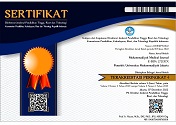Hemodynamic Monitoring of Transcatheter Closure in Patients with Patent Foramen Ovale: A Case Study
DOI:
https://doi.org/10.24853/mmj.6.1.7-14Keywords:
hemodynamics, patent foramen ovale, slurred speech, transcatheter closureAbstract
Patent Foramen Ovale (PFO) is a congenital cardiac anomaly characterized by the persistent opening of the foramen ovale, resulting in a right-to-left shunt due to incomplete closure of the interatrial septum after birth. Incidences of PFO is about 25% or 1 in 4 people in the world's population. Methods: this case study aimed to assess hemodynamic changes during transcatheter closure of PFO in an adult patient. The procedure was monitored for changes in ECG, pulse rate, and blood pressure, highlighting potential risks such as puncture wounds. Findings suggest that comprehensive hemodynamic monitoring is essential during PFO closure procedures. A 66 years old man with a history of symptoms of slurred speech symptoms staggering and then fainting then the PFO closure that is taken during disease management during January - May 2024 at RSUPN Dr. Cipto Mangunkusumo (RSCM). Results: during the PFO Closure procedure, there were changes in the ECG rhythm from Sinus Rhythm to PVC Rythm, decrease pulse rate, decrease in the patient's blood pressure from 176/89 to 118/78 mmHg, as well as risks such as puncture wounds. Conclusion: hemodynamic monitoring during transcatheter closure of Patent Foramen Ovale (PFO) is crucial to detect potential changes and complications. Close surveillance is necessary to identify and promptly manage procedural risks.References
Kavinsky CJ, Szerlip M, Goldsweig AM, Amin Z, Boudoulas KD, Carroll JD, et al. SCAI Guidelines for the Management of Patent Foramen Ovale. J Soc Cardiovasc Angiogr Interv. 2022;1(4):100039.
Hara H, Virmani R, Ladich E, Mackey-Bojack S, Titus J, Reisman M, et al. Patent foramen ovale: current pathology, pathophysiology, and clinical status. J Am Coll Cardiol. 2005 Nov;46(9):1768–76.
Hampton T, Alsaleem M, Murphy-Lavoie HM. Patent Foramen Ovale. In Treasure Island (FL); 2025.
Tiksnadi B, Sylviana N, Cahyadi A, Undarsa A. Routine Exercise to Improve Immunity in Hypertensive Patients During COVID 19 Pandemic. Indones J Cardiol. 2020 Jun 30;41(2 SE-Review Article).
Malhotra K, Katsanos A, Frogoudak A, Vrettou A-R, Ikonomidis I, Tsivgoulis G. Patent Foramen Ovale: Risk Factors and Diagnostic Comparison of Transcranial Doppler versus Echocardiography for Secondary Stroke Prevention. J Neurosonol Neuroimag. 2019 Jun 30;11(1):22–33.
Chugh C. Acute Ischemic Stroke: Management Approach. Indian J Crit care Med peer-reviewed, Off Publ Indian Soc Crit Care Med. 2019 Jun;23(Suppl 2):S140–6.
Cao W, Shen Y, Zhong J, Chen Z, Wang N, Yang J. The Patent Foramen Ovale and Migraine: Associated Mechanisms and Perspectives from MRI Evidence. Brain Sci. 2022 Jul;12(7).
Rizkia A, Widyantari DD, Shofiyanti NI, Putri NPWPN, Syamsun A. Hubungan Antara Patensi Foramen Ovale dengan Kejadian Decompression Sickness. Essent Essence Sci Med J. 2023 Dec 2;21(1).
Meier B, Lock JE. Contemporary management of patent foramen ovale. Circulation. 2003 Jan;107(1):5–9.
Saver JL, Mattle HP, Thaler D. Patent Foramen Ovale Closure Versus Medical Therapy for Cryptogenic Ischemic Stroke: A Topical Review. Stroke. 2018 Jun;49(6):1541–8.
Collado FMS, Poulin M-F, Murphy JJ, Jneid H, Kavinsky CJ. Patent Foramen Ovale Closure for Stroke Prevention and Other Disorders. J Am Heart Assoc. 2018 Jun;7(12).
Fakultas Kedokteran Universitas Negeri Sebelas Maret. Modul Pemantauan Hemodinamik. 2010.
Thaler BDE. Patient Selection for PFO Closure Based on the RoPE Study. 2014.
Kent DM, Saver JL, Kasner SE, Nelson J, Wang AY, Bannuru RR, et al. Evaluating Therapies to Prevent Future Stroke in Patients with Patent Foramen Ovale. Washington (DC); 2023.
Kent DM, Ruthazer R, Weimar C, Mas J-L, Serena J, Homma S, et al. An index to identify stroke-related vs incidental patent foramen ovale in cryptogenic stroke. Neurology. 2013 Aug;81(7):619–25.
Cipto Mangunkusumo Hospital. Medical Record Cipto Mangunkusumo Hospital. 2024.
Van Dijk A, Bouma B, De Winter R, Hoendermis E, Veldhorst M, Lindeboom JE, et al. Guideline for the closure of patent foramen ovale. NVVC. 2017.
Madhkour R, Meier B. Patent Foramen Ovale Closure, A Contemporary Review. Struct Hear. 2018 Mar 1;2(2):114–20.
Vitarelli A. Patent Foramen Ovale: Pivotal Role of Transesophageal Echocardiography in the Indications for Closure, Assessment of Varying Anatomies and Post-procedure Follow-up. Ultrasound Med Biol. 2019 Aug;45(8):1882–95.
Kersey CB, Medhane F, Pattock AM, Liu L, Huang G, Lele A V, et al. Cardiac Arrest during Transesophageal Echocardiogram (TEE) due to Acute Right Ventricular Failure. Case reports Cardiol. 2021;2021:7427127.
Shaik FA, Slotwiner DJ, Gustafson GM, Dai X. Intra-procedural arrhythmia during cardiac catheterization: A systematic review of literature. World J Cardiol. 2020 Jun;12(6):269–84.
Luo L, Xie Z, Wu Q, Liu Q, Hou H, Wang Y, et al. Transesophageal echocardiography guidance for percutaneous closure of PFO and a new method to improve the diagnosis and safety during the procedures. Front Cardiovasc Med. 2024;11:1428380.
Manda YR, Baradhi KM. Cardiac catheterization risks and complications. Treasure Island (FL): StatPearls Publishing; 2018.
Lee PH, Song J-K, Kim JS, Heo R, Lee S, Kim D-H, et al. Cryptogenic Stroke and High-Risk Patent Foramen Ovale: The DEFENSE-PFO Trial. J Am Coll Cardiol. 2018 May;71(20):2335–42.
Downloads
Published
Issue
Section
License
Authors who publish in the Muhammadiyah Medical Journal agree to the following terms:
- Authors retain copyright and grant Muhammadiyah Medical Journal right of first publication with the work simultaneously licensed under a Creative Commons Attribution Licence that allows others to adapt (remix, transform, and build) upon the work non-commercially with an acknowledgement of the work's authorship and initial publication in Muhammadiyah Medical Journal.
- Authors are permitted to share (copy and redistribute) the journal's published version of the work non-commercially (e.g., post it to an institutional repository or publish it in a book), with an acknowledgement of its initial publication in Muhammadiyah Medical Journal.







